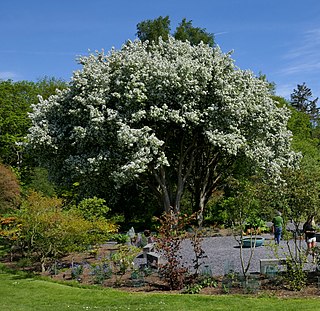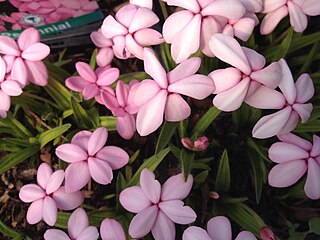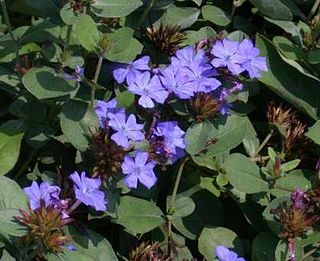
Gaura was a genus of flowering plants in the family Onagraceae, native to North America. The name was derived from Greek γαῦρος (gaûros) meaning "superb" and named in reference to the stature and floral display of some species in this genus. The genus included many species known commonly as beeblossoms. Genetic research showed that the genus was paraphyletic unless the monotypic genus Stenosiphon is included within Gaura, increasing the number of species in the genus to 22. Gaura is now a synonym of Oenothera, with the bulk of the Gaura taxa in genus Oenotherasect. Gaura(L.) W.L.Wagner &Hoch.

Malus hupehensis, common names Chinese crab apple, Hupeh crab or tea crabapple, is a species of flowering plant in the apple genus Malus of the family Rosaceae.

Verbena bonariensis, the purpletop vervain, clustertop vervain, Argentinian vervain, tall verbena or pretty verbena, is a member of the verbena family cultivated as a flowering annual or herbaceous perennial plant. In USA horticulture, it is also known by the ambiguous names purpletop and South American vervain. For the misapplication "Brazilian verbena" see below.

Rosa minutifolia is a species in the genus Rosa. It is also known by the common names Baja rose, Baja littleleaf rose, and small-leaved rose.

Brodiaea californica, with the common name California brodiaea, is a species of plant in the genus Brodiaea.

Oenothera suffrutescens is a species of flowering plant in the evening primrose family known as scarlet beeblossom and scarlet gaura.

Salvia leucantha, the Mexican bush sage, is a herbaceous perennial plant that is native to subtropical and tropical conifer forests in central and eastern Mexico. The flowers are usually white, emerging from coloured bracts. It is not frost hardy, but is often grown in warmer latitudes for its prominent arching velvety blue or purple inflorescences.

Medinilla magnifica, the showy medinilla or rose grape, is a species of flowering plant in the family Melastomataceae, native to the Philippines. It is an epiphyte. Various species and hybrids in this family are well known and popular with plant collectors with Medinilla speciosa being found almost identical.

Lysimachia latifolia, sometimes called Trientalis latifolia, is a species of flowering plant in the family Primulaceae. It is known as starflower, chickweed-wintergreen, or Pacific starflower.

Echeveria elegans, the Mexican snow ball, God's Throne, Mexican gem or white Mexican rose is a species of flowering plant in the family Crassulaceae, native to semi-desert habitats in Mexico.

Hydrangea paniculata, or panicled hydrangea, is a species of flowering plant in the family Hydrangeaceae native to southern and eastern China, Korea, Japan and Russia (Sakhalin). It was first formally described by Philipp Franz von Siebold in 1829.

Clematis armandii is a flowering climbing plant of the genus Clematis. Like many members of that genus, it is prized by gardeners for its showy flowers. It is native to much of China and northern Burma. The plant is a woody perennial. It attracts bees, butterflies, and hummingbirds.

Clerodendrum trichotomum, the harlequin glorybower, glorytree or peanut butter tree, is a species of flowering plant in the family Lamiaceae. It is native to China, Korea, Taiwan, Japan, India, and the Philippines.

Colchicum × byzantinum, the Byzantine meadow saffron, is a species of flowering plant in the family Colchicaceae with a long history of cultivation, and no certain place of origin. It is thought to be a hybrid of other species.

Ceratostigma willmottianum, Chinese plumbago, is a species of flowering plant in the family Plumbaginaceae that is native to western China and Tibet. It is an ornamental deciduous shrub that grows to 1 metre in height, with pale blue plumbago-like flowers appearing in autumn as the leaves start to turn red.

Omphalodes cappadocica, the Cappadocian navelwort, is a species of flowering plant in the family Boraginaceae, native to woodland habitats in Turkey. It is an evergreen perennial growing to 25 cm (10 in) tall by 40 cm (16 in) wide, with slightly hairy, oval pointed leaves and loose terminal racemes of bright blue flowers with white eyes, similar to forget-me-nots, appearing in spring.
Prunus apetala is a species of flowering cherry in the genus Prunus in the family Rosaceae. It is called clove cherry, because of its clovebud-shaped calyx. It is native to Japan, centered on the main island, Honshu.

Rhodohypoxis baurii, the red star or rosy posy, is a species of flowering plant in the family Hypoxidae that is native to damp meadows in eastern South Africa. Growing to no more than 10 cm (3.9 in) tall and broad, it is a herbaceous perennial with lanceolate, sharply folded, hairy grey-green leaves, and pale or deep pink star-shaped flowers throughout summer. The upturned flowers are held on slender, short straight stalks. The tepals are of equal length and held alternately in two ranks.

Osmanthus yunnanensis is a species of flowering plant in the olive family Oleaceae, native to Yunnan and Sichuan in the far south west of China. Growing to 12 m (39 ft) tall and broad, it is an evergreen shrub or small tree with leathery oval leaves, which may be flat or undulate. In winter and spring, small clusters of white flowers in the leaf axils produce an intense fragrance.

Ceratostigma plumbaginoides (蓝雪花), the hardy blue-flowered leadwort, is a species of flowering plant in the plumbago family, native to Western China, where it is usually found in rocky foothills.




















